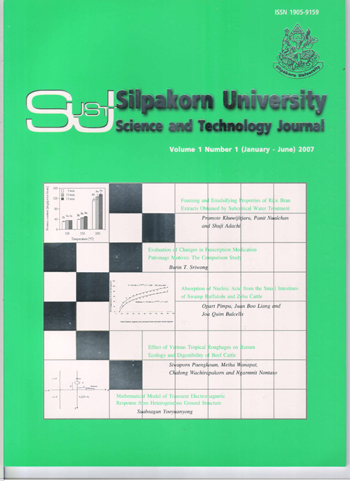Effect of Various Tropical Roughages on Rumen Ecology and Digestibility of Beef Cattle
Main Article Content
Abstract
Four-fistulated, castrated male crossbred cattle were randomly allocated to a 4 x 4 Latin square design. The treatments were: T1) urea-treated (5%) rice straw (UTS); T2) cassava hay (CH); T3) fresh cassava foliage (FCF); T4) UTS: FCF (1: 1 dry matter basis). Faecal and feed samples were collected during the last seven days of each period and analyzed for DM, Ash, CP, NDF ADF and acid-insoluble ash (AIA). Rumen fluid and blood samples were collected on the last day of each period at 0, 2 and 4 h-post feeding and then analyzed for microorganisms (total viable and cellulolytic bacteria), NH3-N, volatile fatty acid (VFA) and blood urea-nitrogen (BUN). The results revealed that total viable and cellulolytic bacterial population were enhanced (P < 0.05) with UTS as the roughage source. Animals fed with FCF had a higher rumen propionate production (P < 0.05) with a lower cellulolytic bacteria count. In addition, roughage intake and total DM intake were highest by using UTS (2.2 and 2.5 %BW, respectively) as the roughage source (P < 0.05). Organic matter intakes were similar among among UTS, CH and UTS: FCF treatments (8.0, 6.8 and 8.7 kg/d, respectively). Digestion coefficients of DM and OM were similar among treatments. However CP digestion coefficients were similar among CH, FCF and UTS: FCF treatments, but were higher (P < 0.05) in CH than in UTS. It was also observed that feeding FCF as a full-feed resulted in anorexia and ataxia as well as frequent urination. Therefore FCF should only be fed fresh as part of the feed or should be fed wilted. Hence, combined use of FCF and UTS as well as CH and FCF were recommended.
Downloads
Article Details
References
Bromner, J. M., and Keeney, D. R. (1965). Steam distillation methods of determination of ammonium, nitrate and nitrite. Analysis Chemistry Acta, 32: 485.
Cressman, S. G., Grieve, D. G., McLoad, G. K., Wheeler, E. E., and Young, L. G. (1980). Influence of dietary protein concentration on milk production by dairy cattle in early lactation. Journal of Dairy Science, 63: 1839-1847.
Crocker, C. L. (1967). Rapid determination of urea nitrogen in serum or plasma without deprotenization. American Journal Medical Technology, 33: 361.
Goering, H. K., and Van Soest, P. J. (1970). Forage fiber analysis (Apparatus, Reagent, Procedures and some Application). In Agricultural Handbook. No. 397, ARS, USDA, Washington, D.C.
Hungate, R. E. (1966). The rumen and it microbes. Academic Press, New York, NY.
Hungate, R. E. (1969). A roll tube method for cultivation of strict anaerobes. In Methods in Microbiology, (Norris, J.R. and Ribbons, D. W., eds), New York: Academic, 313: 117.
Kanjanapruthipong, J., and Leng, R. A. (1998). The effects of dietary urea on microbial populations in the rumen of sheep. Asian Australasian Journal of Animal Science, 11: 661-672.
Koike, S., and Kobayashi, Y. (2001). Development and use of competitive PCR assays for the rumen cellulolytic bacteria: Fibrobacter succinogenes, Ruminococcus albus and Ruminococcus flavefaciens. FEMS Microbiology Letter, 204: 361-366.
Krause, D. O., Bunch, R. J., Smith, W. J. M., and McSweeney, C. S. (1999). Diversity of Ruminococcus strains: A survey of genetic polymorphisms and plant digestibility. Journal of Applied Microbiology, 86: 487-495.
Perdok, H. B., and Leng, L. A. (1990). Effect of supplementation with protein meal on the growth of cattle given a basal diet of untreated ammoniated rice straw. Asian Australasian Journal of Animal Science, 3: 269-279.
Reed, J. D. (1995). Nutritional toxicology of tannins and related prolyphenols in forage legumes. Journal of Animal Science, 73: 1516-1528.
Samuel, M., Sagathewan, S., Thomas, J., and Mathen, G (1997). An HPLC method for estimation of volatile fatty acids of ruminal fluid. Indian Journal of Animal Science, 67: 805.
SAS. (1999). User s Guide: Statistics, Version 5 Edition. SAS. Inst. Cary, N.C.
Steel, R. G. D., and Torries, J. H. (1980). Principles and Procedures of Statistic a Biomatereal Approach. (2nd ed), McGrow-Hill. New York: U.S.A.
Van Keulen, J., and Young, B. A. (1977). Evaluation of acid insoluble ash as a neutral marker in ruminants digestibility studies. Journal of Animal Science, 44: 282-287.
Wanapat, M. (1985). Improving rice straw quality as ruminant feed by urea-treated in Thailand. In Proc. of Relevance of crop residues as animal feeds in developing countries. (M. Wanapat and Devendra, C., eds) Funny Press, Bangkok, Thailand.
Wanapat, M. (1999). Feeding of ruminants in the tropics based on local feed resources. Khon Kaen Publishing Company Ltd., Khon Kaen, Thailand. 236 p.
Wanapat, M. (2000). Rumen manipulation to increase the efficient use of local feed resources and productivity of ruminants in the Tropics. Asian Australasian Journal of Animal Science, 13 (Suppl.): 59-67.
Wanapat, M., Sundstol, F., and Hall, J. M. R. (1986). A comparison of alkali treatment methods used to improve the nutritive value of straw. II. in sacco and in vitro degradation relative to in vivo digestibility. Animal Feed Science and Technology, 14: 215-220.
Wanapat, M., Pimpa, O., Petlum, A., and U. Boontao. (1997). Cassava hay: A new strategic feed for ruminants during the dry season. Livestock Research for Rural Development, 9(2); LRRD Home Page. Accessed on March 10, 2005.
Wanapat, M., and Pimpa, O. (1999). Effect of ruminal NH,-N levels on ruminal fermentation, purine derivatives, digestibility and rice straw intake in swamp buffaloes. Asian Australasian Journal of Animal Science, 12: 904-907.
Wanapat, M., Notaso, N., Yuangklang, C., Wora-anu, S., Ngarmsaeng, A., achirapakorn, C., and Rowlinson, P. (2003). A comparative study between wamp buffalo and native cattle in feed digestibility and potential transfer of buffalo rumen into cattle. Asian Australasian Journal of Animal Science, 16: 504-510.
Weimer, P. J. (1996). Why don't ruminal bacteria digest cellulose faster. Journal of Dairy Science, 79: 1496-1502.


